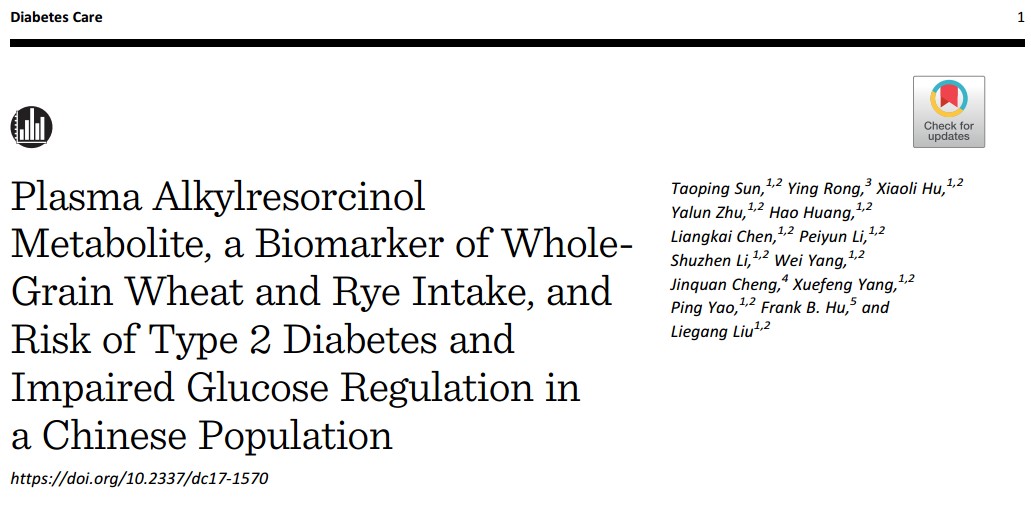Wuhan, China — On Dec 20, 2017, Diabetes Care, an internationally authoritative journal, published the article titled "Plasma Alkylresorcinol Metabolite, a Biomarker of Whole-Grain Wheat and Rye Intake, and Risk of Type 2 Diabetes and Impaired Glucose Regulation in a Chinese Population" by Professor Liu Liegang's team from the School of Public Health, Tongji Medical College, Huazhong University of Science and Technology. Professor Liu and Professor Frank B. Hu at Harvard are listed as corresponding authors. This article is the third academic paper published by Professor Liu's team on this journal, and the first two are both highly cited by ESI.
Type 2 diabetes mellitus (T2DM), also known as non-insulin dependent diabetes mellitus, usually occurs after 35 to 40 years old, and accounts for more than 90% of diabetes cases. The prevalence of T2DM has dramatically increased over the past few decades worldwide, leading to considerable increases in related mortality and economic cost. How to prevent and control the epidemic of T2DM have become major national public health problems.
Although there are several modifiable risk factors for T2DM, diet is clearly of paramount importance. Epidemiological studies have provided consistent evidence suggesting an inverse association between whole-grain intake and risk of T2DM.
All these studies on whole grains generally assessed individual whole-grain consumption through self-administered food frequency questionnaires. However, it is always challenging in free-living populations to accurately measure food and nutrient intakes, especially for whole-grain intake due to the limitations of whole-grain food composition data. Inaccurate identification of different whole-grain constituents as well as incorrect estimation of whole-grain foods can lead to measurement errors and underestimates of health benefits of whole grains. These together make dietary biomarkers significant as additional estimates of dietary intake.
Alkylresorcinols are phenolic lipids present almost exclusively in the bran layers of rye and wheat grain, but absent in highly refined white flour and most other cereal products. About half (45%-71%) of alkylresorcinols are absorbed, and intact alkylresorcinols and their main metabolites (DHBA and DHPPA) are measurable in plasma. Recently, they have been suggested as biomarkers of whole-grain wheat and rye intake in epidemiologic studies. Considering that the estimated half-life is significantly longer for DHPPA (16.3 h) than DHBA (10.1 h) and alkylresorcinols (5 h), plasma DHPPA appears to be a good and specific biomarker of whole-grain wheat and rye intake.
In this research, we established a new LC-MS/MS method with high sensitivity, short running time and simple pretreatment to measure DHPPA concentrations in plasma from over 3000 subjects. To the best of our knowledge, this was the first study to examine the relationship between plasma DHPPA concentration as a biomarker of whole-grain intake and risk of T2DM and pre-diabetes. We found that higher plasma DHPPA concentration was associated with lower odds of T2DM. Our research provided further evidence for the role of whole-grain intake in preventing T2DM and a new approach to nutritional epidemiology.
Chinese News Link: http://gwxy.tjmu.edu.cn/info/1067/2114.htm
For more details of the paper, please visit: http://care.diabetesjournals.org/content/41/3/440.long



